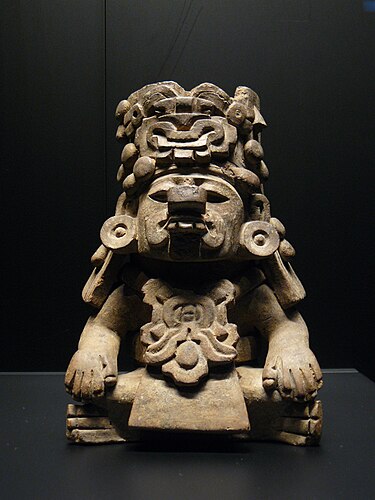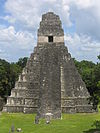Mesoamerica (Spanish: Mesoamérica) is a region and cultural area in the Americas, extending approximately from central Mexico to Belize, Guatemala, El Salvador, Honduras, Nicaragua, and Costa Rica, within which a number of pre-Columbian societies flourished before the Spanish colonization of the Americas in the 15th and 16th centuries.
As a cultural area, Mesoamerica is defined by a mosaic of cultural traits developed and shared by its indigenous cultures. Beginning as early as 7000 BC the domestication of maize, beans, squash and chili, as well as the turkey and dog, caused a transition from paleo-Indian hunter-gatherer tribal grouping to the organization of sedentary agricultural villages. In the subsequent formative period, agriculture and cultural traits such as a complex mythological and religious tradition, a vigesimal numeric system, and a complex calendric system, a tradition of ball playing, and a distinct architectural style, were diffused through the area. Also in this period villages began to become socially stratified and develop into chiefdoms with the development of large ceremonial centers, interconnected by a network of trade routes for the exchange of luxury goods such as obsidian, jade, cacao, cinnabar, Spondylus shells, hematite, and ceramics. While Mesoamerican civilization did know of the wheel and basic metallurgy, neither of these technologies became culturally important.
Among the earliest complex civilizations was the Olmec culture which inhabited the Gulf coast of Mexico. In the Preclassic period, complex urban polities began to develop among the Maya and the Zapotecs. During this period the first true Mesoamerican writing systems were developed in the Epi-Olmec and the Zapotec cultures, and the Mesoamerican writing tradition reached its height in the Classic Maya Hieroglyphic script. Mesoamerica is one of only five regions of the world where writing was independently developed. In Central Mexico, the height of the Classic period saw the ascendancy of the city of Teotihuacan, which formed a military and commercial empire whose political influence stretched south into the Maya area and northward. During the Epi-Classic period the Nahua peoples began moving south into Mesoamerica from the North. During the early post-Classic period Central Mexico was dominated by the Toltec culture, Oaxaca by the Mixtec, and the lowland Maya area had important centers at Chichén Itzá and Mayapán. Towards the end of the post-Classic period the Aztecs of Central Mexico built a tributary empire covering most of central Mesoamerica.
Selected article

Olmec figurines are archetypical figurines that were produced by the Formative Period inhabitants of Mesoamerica. While many of these figurines may or may not have been produced directly by the people of the Olmec heartland, they bear the hallmarks and motifs of Olmec culture.
These figurines are usually found in household refuse, in ancient construction fill, and (outside the Olmec heartland) in graves, although many Olmec-style figurines, particularly those labelled as Las Bocas- or Xochipala-style, were recovered by looters and are therefore without provenance.
The vast majority of figurines are simple in design, often nude or with a minimum of clothing, and made of local terracotta. Most of these recoveries are mere fragments: a head, arm, torso, or a leg. It is thought, based on wooden busts recovered from the water-logged El Manati site, that figurines were also carved from wood, but, if so, none have survived.
More durable and better known by the general public are those figurines carved, usually with a degree of skill, from jade, serpentine, greenstone, basalt, and other minerals and stones.
Selected biography

Sylvanus Griswold Morley (June 7, 1883 – September 2, 1948) was an American archaeologist, epigrapher, and Mayanist scholar who made significant contributions toward the study of the pre-Columbian Maya civilization in the early 20th century.
Morley is particularly noted for the extensive excavations of the Maya site of Chichen Itza that he directed on behalf of the Carnegie Institution. He also published several large compilations and treatises on Maya hieroglyphic writing, and wrote popular accounts on the Maya for a general audience.
To his contemporaries, "Vay" Morley was one of the leading Mesoamerican archaeologists of his day. Although more recent developments in the field have resulted in a re-evaluation of his theories and works, his publications, particularly on calendric inscriptions, are still cited. In his role as director of various projects sponsored by the Carnegie Institution, he oversaw and encouraged many others who later established notable careers in their own right. His commitment and enthusiasm for Maya studies helped inspire the necessary sponsorship for projects that would ultimately reveal much about ancient Maya civilization.
Morley also conducted espionage in Mexico on behalf of the United States during World War I, but the scope of those activities only came to light well after his death. His archaeological field work in Mexico and Central America provided suitable cover for investigating German activities and anti-American activity at the behest of the United States' Office of Naval Intelligence.
Did you know?
- ... that the ancient city of Tikal (pictured) in Guatemala was one of the most powerful kingdoms of the ancient Maya civilization?
- ... that the pre-Columbian ruins of Dainzú in Mexico are distinguished by their gallery of bas-reliefs representing ball-players?
Subcategories
Related portals
Selected image
 |
Cocijo (occasionally spelt Cociyo) is a lightning deity of the pre-Columbian Zapotec civilization of southern Mexico. He has attributes characteristic of similar Mesoamerican deities associated with rain, thunder and lightning, such as Tlaloc of central Mexico. Cocijo was the most important deity among the pre-Columbian Zapotecs because of his association with rainfall.
Featured articles
Good Topics
Good articles
 Gómez de Alvarado
Gómez de Alvarado Aztecs
Aztecs La Blanca, Peten
La Blanca, Peten Calakmul
Calakmul Bartolomé de las Casas
Bartolomé de las Casas Copán
Copán El Chal
El Chal Haʼ Kʼin Xook
Haʼ Kʼin Xook Itzam Kʼan Ahk II
Itzam Kʼan Ahk II Iximche
Iximche Kʼinich Yat Ahk II
Kʼinich Yat Ahk II Kʼinich Yoʼnal Ahk I
Kʼinich Yoʼnal Ahk I Macuahuitl
Macuahuitl Maize
Maize Manche Chʼol
Manche Chʼol Mixco Viejo
Mixco Viejo Motul de San José
Motul de San José Mundo Perdido, Tikal
Mundo Perdido, Tikal North Acropolis, Tikal
North Acropolis, Tikal Potbelly sculpture
Potbelly sculpture William H. Prescott
William H. Prescott Qʼumarkaj
Qʼumarkaj Resplendent quetzal
Resplendent quetzal Seibal
Seibal Serpent labret with articulated tongue
Serpent labret with articulated tongue Spanish conquest of Yucatán
Spanish conquest of Yucatán Spanish conquest of Chiapas
Spanish conquest of Chiapas Spanish conquest of El Salvador
Spanish conquest of El Salvador Spanish conquest of Honduras
Spanish conquest of Honduras Spanish conquest of the Maya
Spanish conquest of the Maya Tikal
Tikal Toniná
Toniná Western Mexico shaft tomb tradition
Western Mexico shaft tomb tradition Benjamin Lee Whorf
Benjamin Lee Whorf Yoʼnal Ahk III
Yoʼnal Ahk III Zaculeu
Zaculeu
Topics
WikiProjects
New articles
Rules | Match log | Results page (for watching) | Last updated: 2024-06-17 20:55 (UTC)
Note: The list display can now be customized by each user. See List display personalization for details.
- 2024 dengue outbreak in Latin America and the Caribbean ( | talk | history | links | watch | logs | tools) by Noble Attempt (talk · contribs · new pages (15)) started on 2024-06-16, score: 54
- Ixchelia ( | talk | history | links | watch | logs | tools) by Tom Radulovich (talk · contribs · new pages (101)) started on 2024-06-12, score: 44
- Los Danzantes ( | talk | history | links | watch | logs | tools) by Another Believer (talk · contribs · new pages (152)) started on 2024-06-08, score: 30
- Christopher T. Fisher ( | talk | history | links | watch | logs | tools) by Joe Roe (talk · contribs · new pages (3)) started on 2024-06-05, score: 40
- Mesoamerican Epiclassic Period ( | talk | history | links | watch | logs | tools) by IntergalacticOboist (talk · contribs · new pages (3)) started on 2024-06-05, score: 88
Associated Wikimedia
The following Wikimedia Foundation sister projects provide more on this subject:
-
 Commons
Commons
Free media repository -
 Wikibooks
Wikibooks
Free textbooks and manuals -
 Wikidata
Wikidata
Free knowledge base -
 Wikinews
Wikinews
Free-content news -
 Wikiquote
Wikiquote
Collection of quotations -
 Wikisource
Wikisource
Free-content library -
 Wikiversity
Wikiversity
Free learning tools -
 Wiktionary
Wiktionary
Dictionary and thesaurus
-

-

-

-

-
Random portal
Purge server cache















Recent Comments